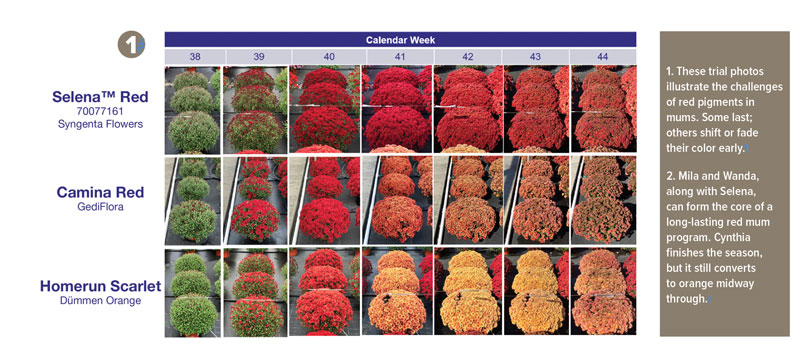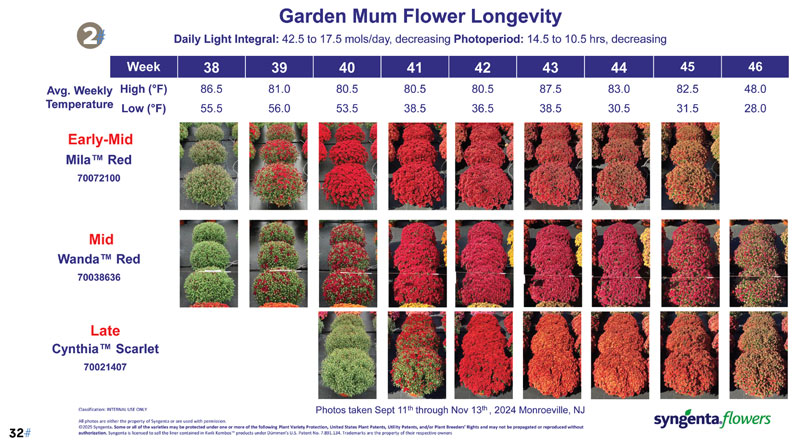9/30/2025
The Significance of Selena Red
Lowell Halvorson

What makes Selena Red so attractive is that it enhances the most valuable portion of a mum’s lifespan: the display window. This is the length of time mums are attractive on the bench or porch. Improving that performance has financial impacts directly and indirectly. The longer a plant is in prime color, the longer the retail sales window. A product that lasts after the sale also generates repeat business next year.
Selena Red’s strong show with long-lasting results is a good sign for chrysanthemums. Red has the lowest sales of the core colors, in large part due to its shorter lifespan of color after the sale. However, Selena Red shows that the genetics to solve the color-fast problem for red is somewhere inside the plant.
Color durability is an important issue for chrysanthemums because they face competition with other color-durable products. I would argue their primary competitor is plastic, but you could argue pumpkins, gourds, cornstalks and millet also set the pace. I’m not asking mums to return to their roots as a garden perennial—the job of autumn decor is to color the house. Four weeks is credible; two weeks is weak sauce trying to cover tough meat.
Unpacking the colors
Photography from the mum trials at Lucas Greenhouses in New Jersey last year captures an important moment for the industry. Amidst the core colors, red is notorious for fading early. Among some older varieties still sold today, red transitions from cracking color to retail prime to curling brown by the third week. Vibrancy typically wanes quickly, followed by a dull red or orange and a general degrade of the product.
Fading reds also affect other colors. Oranges have a tendency to melt into yellows because the red component fails before the yellow. Oranges fading to yellow isn’t necessarily a bad thing—if a plant ages gracefully, color shifting can be a fun product feature. However, technically, the consumer bought an orange mum so it should stay orange as long as possible. Even pinks and purples suffer color stability issues because red is in their makeup as well.
Highest ranking for color durability among the mums is yellow, which, not surprisingly, is the most popular selection. Yet even some yellows burn out in less than a month. Still, it’s possible to build a long-lasting mum program from yellows today, but none of the other colors has achieved this capability.
 Long-lasting mums at Syngenta
Long-lasting mums at Syngenta
This history of fading makes the color performance of Selena Red even more remarkable. Until now, reds were largely shrugged off because, you know, they’re reds. What do you expect? Selena Red demonstrates that a different future is possible by keeping pace with most of the yellows. It does a tough job well.
 Even better, Selena Red is not an isolated exception. Strong reds in the Syngenta product line—like Wanda Red, Cynthia Scarlet and especially Mila Red—create more valuable products by lengthening their display window.
Even better, Selena Red is not an isolated exception. Strong reds in the Syngenta product line—like Wanda Red, Cynthia Scarlet and especially Mila Red—create more valuable products by lengthening their display window.
When you pull back and look for full season coverage, you can see this push is still under construction. The quickest path to market in breeding is through the new releases. Right now, locating color durability for most colors is a hop, skip and a jump through the various families and windows. Back-breeding that capability into varieties consumes substantial amounts of development resources, enough to make any major supplier grunt hard.
That effort is also complicated by the extremely local nature of chrysanthemums. Flowering is triggered by daylight length and growing temperatures—two variables unique to each site. You can see the challenge in the highly involved spreadsheets accompanying mum varieties that micro-tune to various micro-schedules. Introducing change is like removing a brick from a Jenga tower. You can do it, but ... carefully is the word I would select.
The pace of change
For this reason, I believe color durability improvements will seep, not sweep, through the chrysanthemum industry. Color duration competes with other top-level breeding goals like filling in the color gaps and white rust resistance. All these desirable features jostle for resources. Color duration is a slow-moving train that will gain speed over time.
If you want your finger on the pulse of chrysanthemums, one of the best places to find it is at the trials conducted by serious mum outfits like Lucas Greenhouses. Trial photos and web site reviews have hints and snips of information, but the real news occurs with site visits and presentations at the trial open houses: listening to the nuances of the conversations, looking in 3D instead of 2D, setting skin on the crop. All that.
I consider Selena Red and Mila Red to be achievements that move the industry forward, but then, there’s always that local spin. Your best proof is your own facility. Bring in a small crop of Selena Red, grow it out and set some finished product by the office door to see how they do. That’s where you’ll find the truth. GT
Lowell Halvorson is a consultant and writer in Fairfield, Connecticut, for retail and wholesale horticulture, specializing in business development. He also covers the breeding community for GrowerTalks magazine. You can contact him at (203) 257-9345 or halvorson@triadicon.com.